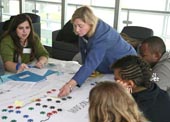
 |
 |
 |
 |
|---|
TERMS YOU SHOULD KNOW
List of Terms
Lamont-Doherty Earth Observatory
 |
Brownfield - an abandoned, unused, or underused industrial or commercial site that has not been redeveloped because of concerns of contamination from hazardous substances.
Eminent domain - the right (power) of the government to take private property without the owner’s consent, either for its own use, or by delegation to a third party who will devote it to ‘public uses’. Some states require that before resorting to the use of eminent domain there must be an offer of purchase to the owner. Governments most commonly use the power of eminent domain to acquire property necessary for completion of public projects such as roads, military installations, or public buildings. However, in 2005 a court decision expanded ‘public good’ to include private economic developments. It permitted the use of eminent domain seizures to allow for commercial development that would generate more tax revenue for the local government.
Gentrification - the process in which the renewal and rebuilding of an area brings an influx of more affluent people into the area resulting in the displacement of poorer residents. Gentrification occurs when low-cost and physically deteriorated neighborhoods undergo a physical renovation. These renovations often lead to an increase in property values for the area. One of the major goals of Urban Renewal is to create this increase in property values. The village or city benefits from an inflow of new residents and increased property values that result in an increased tax base. Property owners often note that the improved conditions in an area can lead to increased funding opportunities for home loans because lenders feel more secure in their investment. A reduction in crime is also often cited. But gentrification also includes the displacement of existing residents because of an increase in the cost of living in the community. This displacement disrupts families and social networks. The burden to relocate most often falls on those least able to find a new location in which to settle.
Home Rule - local governments have the power to adopt and amend (change) local laws, as long as they are not inconsistent with the constitution or general laws. Local laws decide issues of land use planning, appropriate zoning and enforcement. Home Rule places a lot of power and authority at the local level.
Local Waterfront Revitalization Program (LWRP) - New York State’s LWRP is a program of grants and financial assistance to aid waterfront communities in bringing renewed life to their waterfront resources. If approved the local community can work with the state and the federal government to obtain funding assistance.
Mitigate - To mitigate is to offset or reduce the negative impact from something. The SEQRA process requires significant environmental impacts be mitigated so as to reduce their negative affect.
Mixed Use - This type of development is generally an urban development that blends several types of usage in the same project. This can be a blend of residential, commercial, cultural, institutional, or industrial uses where the functions are physically and functionally integrated, witht pedestrian connections.
Ratables - Property that provides tax income for local governements. Often development decisions have been based on the amount of ratables that are included.
SEQRA - The State Environmental Quality Review Act requires local legislatures and land use agencies to consider, avoid, and mitigate significant environmental impacts of the projects that they approve, the plans or regulations they adopt, and the projects they undertake directly. The also allow for any affected party to participate and be heard in the process.
Stakeholders - Different groups and members in your community that will be affected by what happens in a space, or who have a shared interest or concern and therefore would care about what happens to this space. Stakeholders can include agencies, businesses and individuals.
Transit Oriented Development - A type of community development that is built to include transportation concerns at its center. Often a mixture of housing, office, retail and/or other amenities all integrated into a walkable neighborhood and located within a half-mile or less of quality public transportation.
Urban Renewal Plan - long-term plans for improving the economy and community of areas that meet certain defined requirements as “blighted areas” (deteriorated neighborhood) with federal funding assistance.